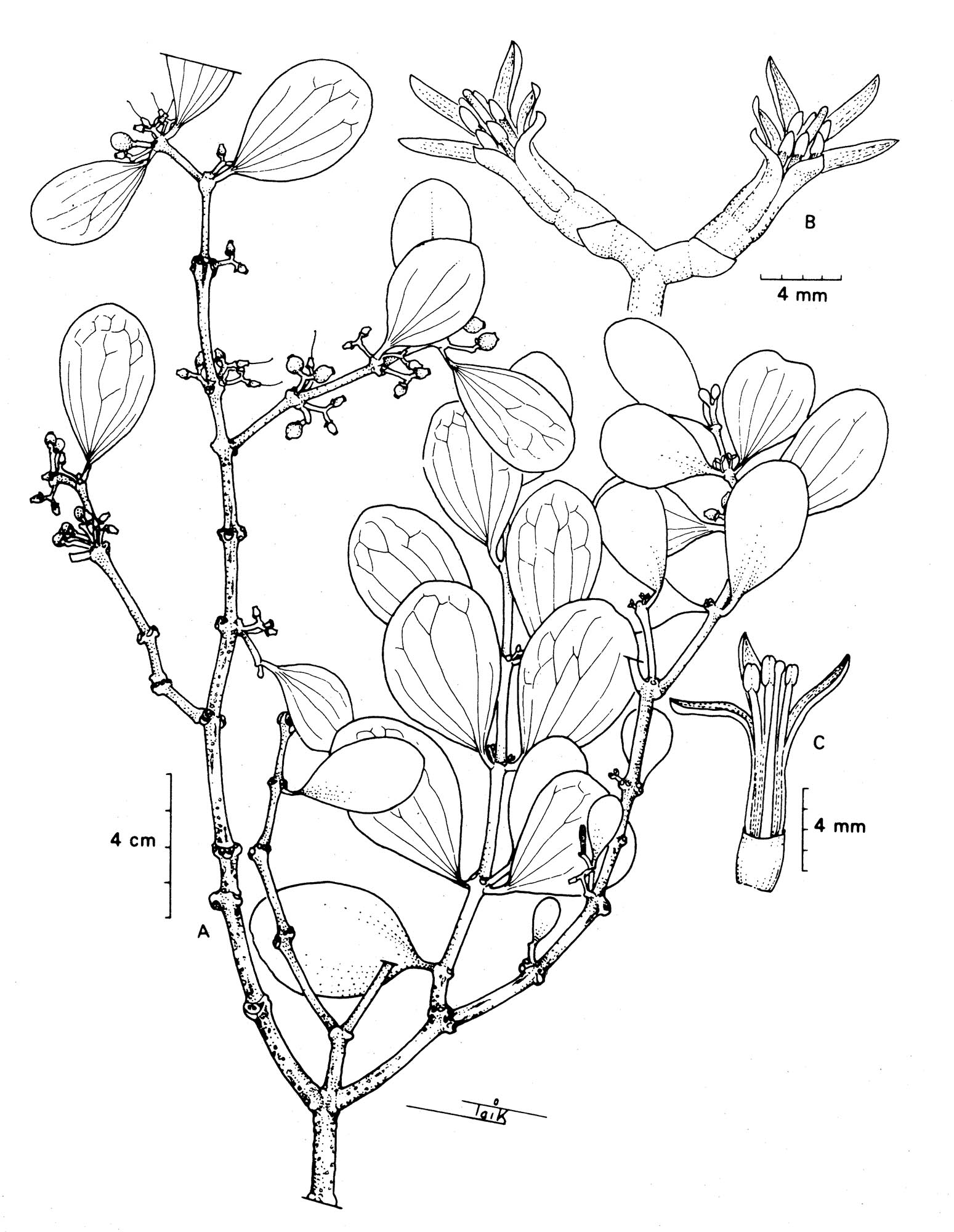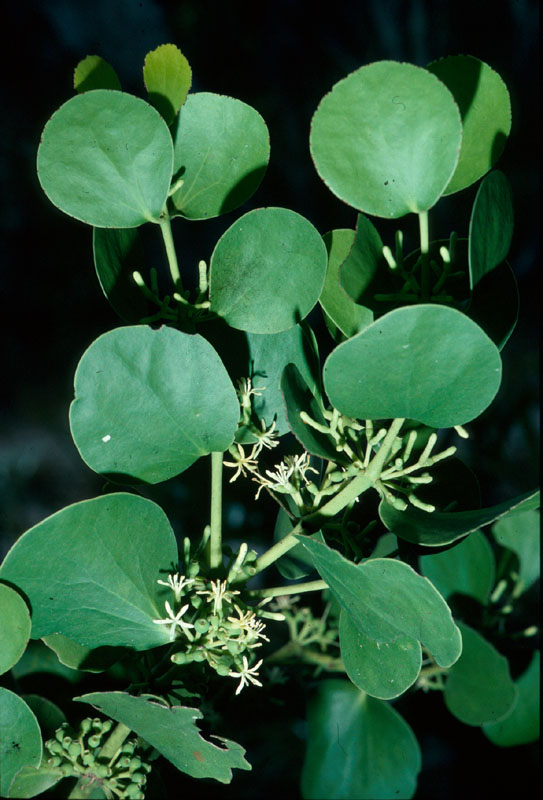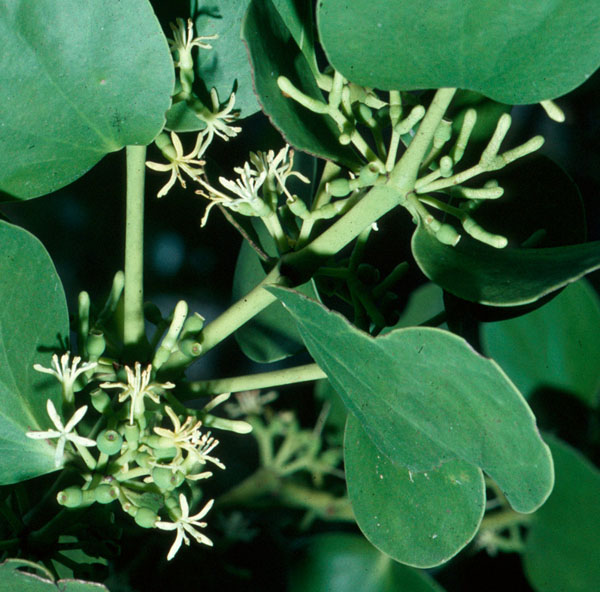
Distribution Map

Description (Barlow 1995)
Phrygilanthus obtusifolius Merrill, Philipp. J. Sei. 1 Suppl. (1906) 189. - Cecarria obtusifolia (Merrill) Barlow in Barlow & Wiens, Brittonia 25 (1973) 34. - Type: Borden FB 1813 (lecto PNH, not extant, see below; iso BO, NY, S, not seen), Philippines, Bataan, Mt Mariveles, Lamao R., 650 m, ix.1904.
For description and additional synonymy see Barlow, Austral. J. Bot. 22 (1974) 556; Flora of Australia 22 (1984) 90. Cecarria obtusifolia can be identified by its opposite obovate leaves 3-5.5 cm long, inflorescence a 2- to 4-flowered raceme or spike, small 6-merous choripetalous corolla, and dorsi fixed versatile anthers. The flower colour is white to pale creamy green.
Cecarria obtusifolia is distributed from the Philippines (Luzon, Mindanao) southwards to the Lesser Sunda Islands (Flores, Timor) and eastwards to New Guinea, the Solomon Islands and northeastern Australia (Fig. 1; 15 collections seen) in closed and open mesic forests. Recorded hosts include Calophyllum, Casuarina, Syzygium and Xanthostemon. The specimens from the Lesser Sunda Islands cited below are new records for the species, and represent a significant extension to the known range.
Cecarria is a monotypic genus. It shows several character states which appear to be plesiomorphic for Loranthaceae, and it is probably a relictual Gondwanan entity (Barlow & Wiens, 1973; Barlow, 1983, 1990). Its small white choripetalous open flowers, presumably insect pollinated, are probably close to the primitive state for the family. Its genome (x = 9) suggests that it is near the stem of the amyemoid genera which differentiated on the Australian tectonic plate (Barlow, 1990).
Perhaps in keeping with its apparently relictual nature, the species has a fragmented distribution, and is apparently nowhere common. It has attained a wide distribution on both sides of Charles's Line, and presumably reached the Lesser Sunda Islands and the Philippines as an early migrant from the Papuasian side of the contact zone.
Barlow (1974, 1984) treated the Philippine Phrygilanthus (Cecarria) obtusifolia and the New Guinean P. novoguineensis Krause as conspecific, although there are some differences in leaf and inflorescence characters. The additional specimens from the Lesser Sunda Islands are more or less intermediate in these characters, suggesting that the differences are clinal ones. This is consistent with the suggestion that the specimens represent a single morphological species with a fragmented distribution.
In the original description Merrill cited three collections, which are therefore syntypes. Danser (1935) listed all three collections, but cited only Borden FB 1813 (PNH) as type, and this is accepted as lectotypification. This specimen is no longer extant, but isotypes not seen in the present study are cited from BO, NY and S, and provide the basis for further lectotypification. Other collections cited by Danser have been seen, including a syntype, Whitford 134.
Selected specimens examined: Verheijen 3189 (L), Lesser Sunda Islands, Flores, Pong Dode,
G. Putih, 22. xii. 1972 (vern. 'Tai-ntala'); Schmutz 3085 (L),
Lesser Sunda Islands, Flores, Kae Valley, Puangteko Creek, 550
m, 9.ii.l973; Bloembergen 3417 (L), Lesser Sunda Islands,
Timor, Bioba to Oi Pula, 680-1200 m, 6.iii.1939.
Description (Barlow 1974)
Cecarria obtusifolia (Merr.) Barlow in Barlow and Wiens, Brittonia 25: 34 (1973); Phrygilanthus obtusifolius Merr. Philipp. J. Sci. 1: suppl. 189 (1906); Muellerina obtusifolia (Krause) Barlow, Proc. Linn. Soc. N.S.W. 87: 60 (1962). Type.- Lamao R., Mt. Mariveles, Bataan, Luzon, Philippines, Whitford 134, May 1904 (Nsw, syntype). This is one of several syntypes, but a lectotype is not selected because not all of the syntypes have been seen.
Phrygilanthus novoguineensis Krause, Bot. Jahrb. 57: 465, 491 (1922); Engl. & Krause, Pfl. Fam. ed. 2 16b: 171 (1935); Muellerina novoguineensis (Krause) Barlow, Proc. Linn. Soc. N.S.W. 87: 60 (1962). Type-New Guinea, Kani Mts., c. 1200 in alt., Schlechter 16733, 30.x.1907 (B, syntype, not seen, possibly destroyed; UC 226650, lectosyntype); New Guinea, Hunstein-Spitze, 1300 in alt., Ledermann 11313 (B, syntype, not seen, possibly destroyed).
Glabrous. Stems terete, smooth. Petiole obscure, 2-6 mm long; lainina spathulate to obovate, 3-5.5 by 2-4.5 cm, dull on both sides, attenuate at the base, rounded at the apex; venation distinct on both sides. Inflorescences several developing successively in the axils; peduncle 6-9 mm long (or when the inflorescence is prolonged into a raceme up to 20 mm long); pedicels 1-3 mm long (or sometimes some flowers sessile, especially the lower ones when the inflorescence is prolonged into a raceme); bracts spreading, rounded, 1 mm long. Calyx barrel-shaped, 1.5-2 mm long; limb erect, entire, 0.5-1 mm long. Corolla in the mature bud 10-14mm long, weakly clavate; petals in the open flower weakly reflexed near the middle, each with a ridge or hood about 1 mm long inside at the apex. Anthers ovoid, 1.5 mm long, with a short sterile tip; free parts of the filaments c. 2 mm long. Style persistent on the fruit for some time, eventually articulate c. 0.5 mm above the base. Fruit almost spherical, c. 8 mm long. (Fig. 1, o, p.) Chromosome Number.- n = 9 (Barlow and Wiens 1971 under Gen. Nov.). Voucher: Barlow 927, see below.
Occurrence. North-eastern New Guinea, New Britain and the Solomon Islands (Fig. 4), 200 to 1200 in altitude. Also Philippines, from Luzon to Mindanao.
Specimens Examined. EASTERN NEW GUINEA: Finisterre Mts., 1000 m alt., Schlechter 18204, 5.ix.1908 (UC); Markham Point, near Lae, 200 m alt., Barlow 927, 5.ii. 1965 (AD; BRI; L; LAE). NEW BRITAIN: 7 miles SE. of Benim, Village, Wariai Subdist., Henty and Frodin NGF 27397, 24.iii.1966, (LAE; L). BOUGAINVILLE: Lake Loloru crater, upper slopes, c. 19 miles N. of Bum, c. 1200 m alt. Schodde 3739, 2.viii.1964 (CANB). SAN CRISTOVAL: East of Wainoni, 480 m alt., Corner RSS 42, 9.viii.1965 (K; AD).
Philippine material, previously treated as
Phrygilanthus obtusifolius, differs slightly from that
from New Guinea, New Britain and Solomon Islands, which was previously
treated as Ph. novoguineensis. Danser (1931) accepted the
two species as distinct with considerable reservation. Forms from
the latter islands differ in having larger, more rounded leaves
more abruptly attenuate at the base, shorter floral pedicels and
somewhat longer calyx limb. These differences seem to be insufficient
for keeping the two species separate.
Illustrations

Cecarria obtusifolia. A - twig with flowers and fruit. B - inflorescence. C - flower with nearer petals and stamens removed. From Barlow (1981).
|
|
|
Cecarria obtusifolia. A - flower. B - node with infructescences. From Barlow (1974). |

Habit of plant in flower (B. Gray 5354). TR14 parish of Kestevene, Leo Creek Road, Cape York, Queensland, Australia. 420 m elev. 27-Nov -1991. Photo by Bruce Gray.

Close-up of flowers from above image. Photo by Bruce Gray.
Cecarria obtusifolia
updated 20 January 2007